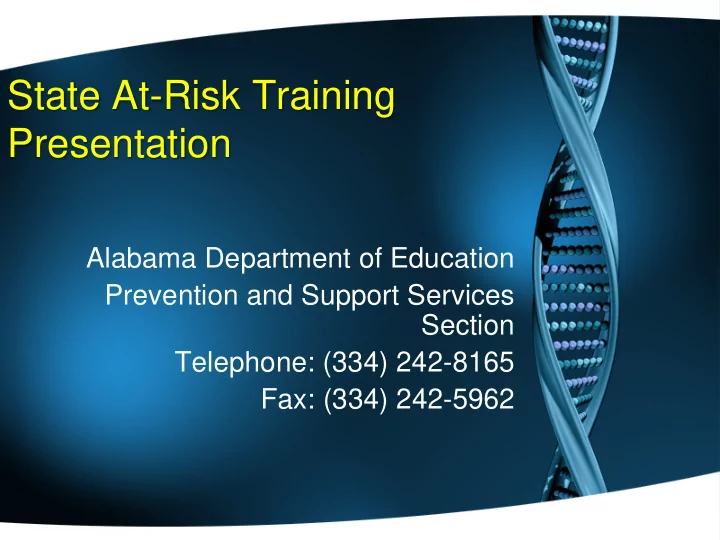

State At-Risk Training Presentation Alabama Department of Education Prevention and Support Services Section Telephone: (334) 242-8165 Fax: (334) 242-5962
State At-Risk Training Presentation Agenda • State At-Risk (At-Risk) Overview • Guidelines • Application Content and Requirements • Flexibility Spending Guidelines • At-Risk Carry-Over Funds
At-Risk Overview The purposes of the At-Risk program funds are as follow: • To keep students in school. • To encourage regular attendance and punctuality. • To better prepare students for the world of work. • To prepare students for further educational opportunities. • To promote and to provide greater safety and security for schools. • To promote greater parental and family support.
At-Risk Overview
State At-Risk Guidelines Purpose of Funding State At-risk funds are for students are defined as being at-risk of dropping out of school or are performing at an academic level below current grade placement (ACT No. 2013-264). These students are at risk of not experiencing school success and are in danger of school failure and/or non-completion. Local school faculty and the school principal shall make recommendations for students at the school to include as participants in the at-risk program.
State At-Risk Guidelines Purpose of Funding Reasons for school failure or non-completion may be due to situations, circumstances, and/or conditions (e.g., environment, family, health, and other) over which they may have limited control. By providing focused attention and assistance in identified areas of need, students will be given opportunities to experience school success. Many of these students may be served at the local level through alternative programs.
State At-Risk Guidelines Purpose of Funding State At-Risk funds may be expended for student programs to improve efficiency and utilization of technology-based educational resources in the classroom (Act 2013-264). They may be used for, but are not limited to, after-school tutoring, summer schools, weekend schools, character education programs, drop-out prevention programs, career technical education youth programs, alternative schools, training of parents, purchase and use of web-based practice tests for standardized tests, programs to improve reading, and/or math, and/or science skills to increase grade-to-grade promotion, high school graduation and college preparedness, and other activities designed to assist at-risk students.
Application Content • To streamline the At-Risk application process for the FY 2017 school year and to facilitate a faster application response time, please indicate the At-Risk allocated funds in your general budget codes. The following codes will be allowed for these funds: – 1.4600 At-Risk Non-regular Education – 2.1700 Alternative School Programs – 3.1810 At-Risk Supplementary Regular Education • Other related program codes may be approved on a case-by-case basis.
Application Requirements AT-RISK FUNDING At-risk students shall be defined as those students who score at level 1 or level 2 (not Requirements by Law proficient/partially proficient) in reading or mathematics on the current state assessments. Assessment of need through committee; Identification of strategies and community agency Planning Guidelines resources; Planning of activities; Development of method of evaluation. At-risk funds may be expended for student programs to improve the efficiency and utilization of Spending Guidelines technology-based educational resources in the classroom. Encourages membership on planning team; funds may be expended on personnel and services Family Involvement that enhance family responsibility. Documentation of evaluation of measurable strategies through academic and behavioral Evaluation Guidelines activities and community agency assessments. Signatures of approval from the At-Risk Planning Team must be kept on file at the central office Signature Guidelines by the At-Risk Coordinator. Supplanting Guidelines The local board may not use State At-Risk funds to supplant existing and/or current resources.
Community Partnership Suggested Guidelines • The requirement to partner with agencies was removed from the law for the 2013-2014 school year. • If you choose to include community organizational support, they must have established non-profit, non- governmental status to be considered as a partner. An organization should not be considered if it cannot and has not established non-profit, non- governmental status under section 501 (c)(3) through appropriate Internal Revenue Service (IRS) documentation .
Flexibility Spending Guidelines For FY 2016 , local boards of education may exercise flexibility among line item expenditures, not to create a reduction of earned teacher units and/or local board of education support personnel. (ACT No. 2013-264 , Education Trust Fund, Section 11 )
At-Risk Carry-Over Funds No carry-over expenditures are permitted under the FY 2013 and the FY 2014 requirements.
Technical Assistance For more information regarding the Alabama Student Assistance Plan, please call Prevention and Support Services at telephone number (334) 242-8165.
Recommend
More recommend